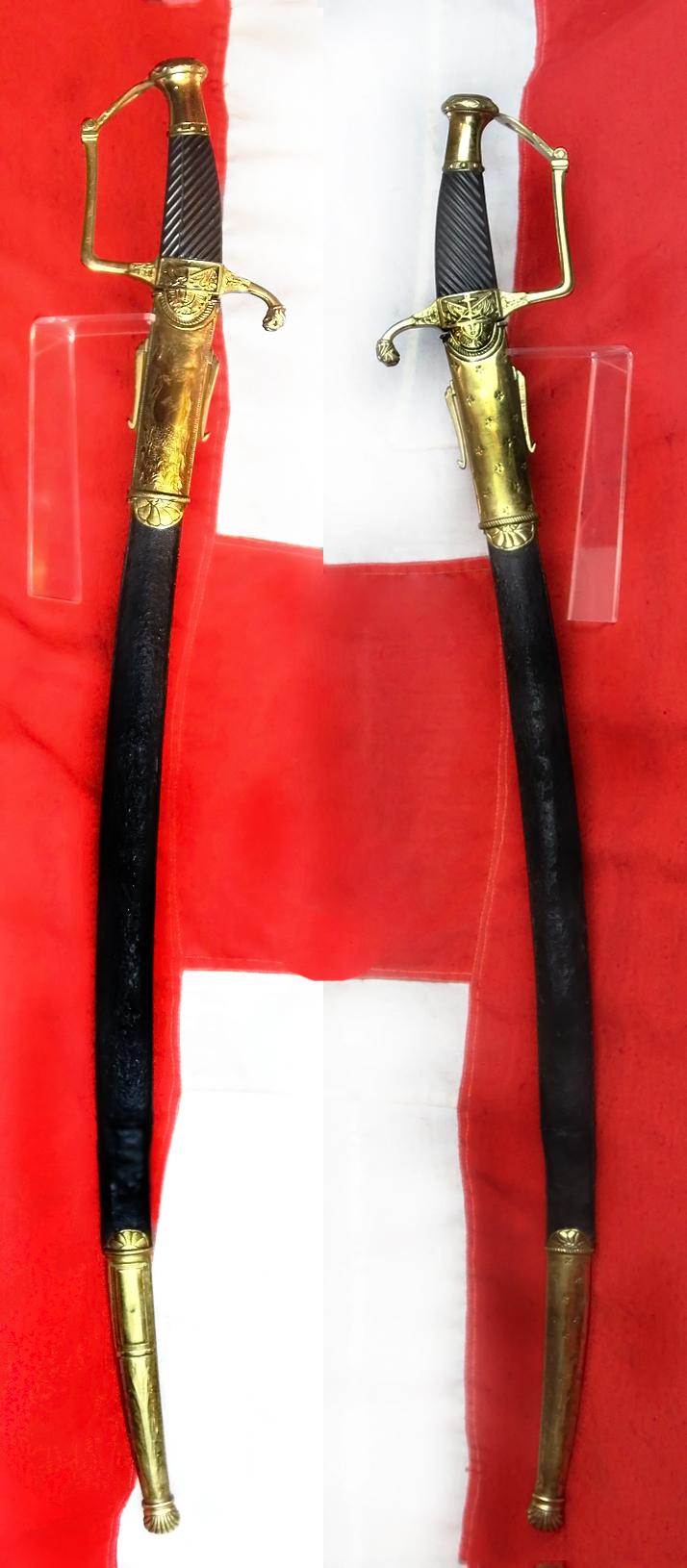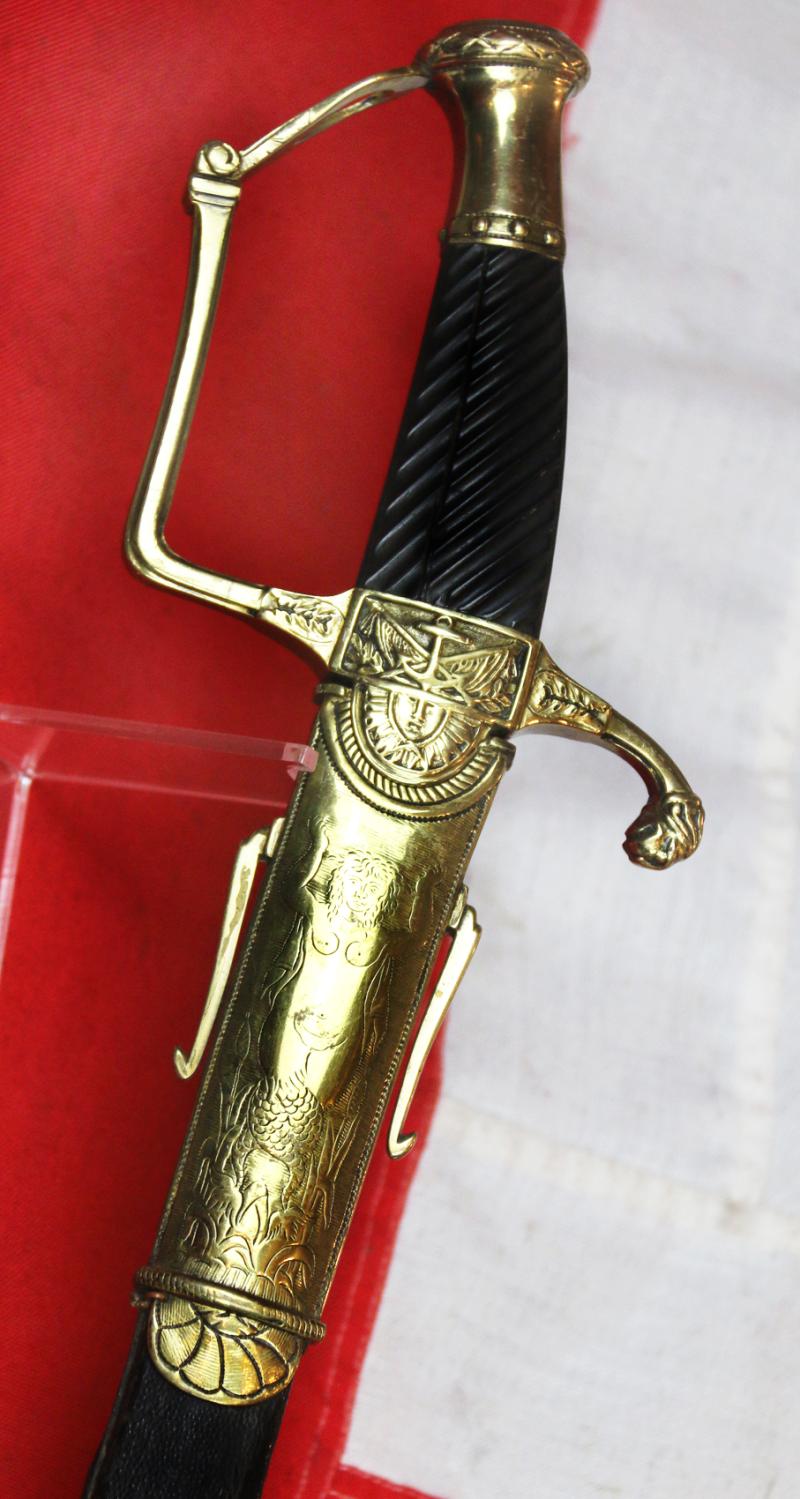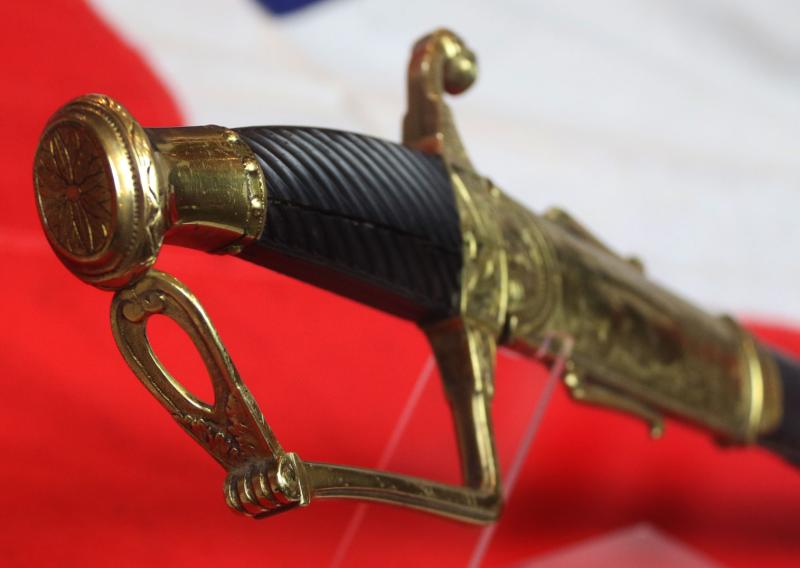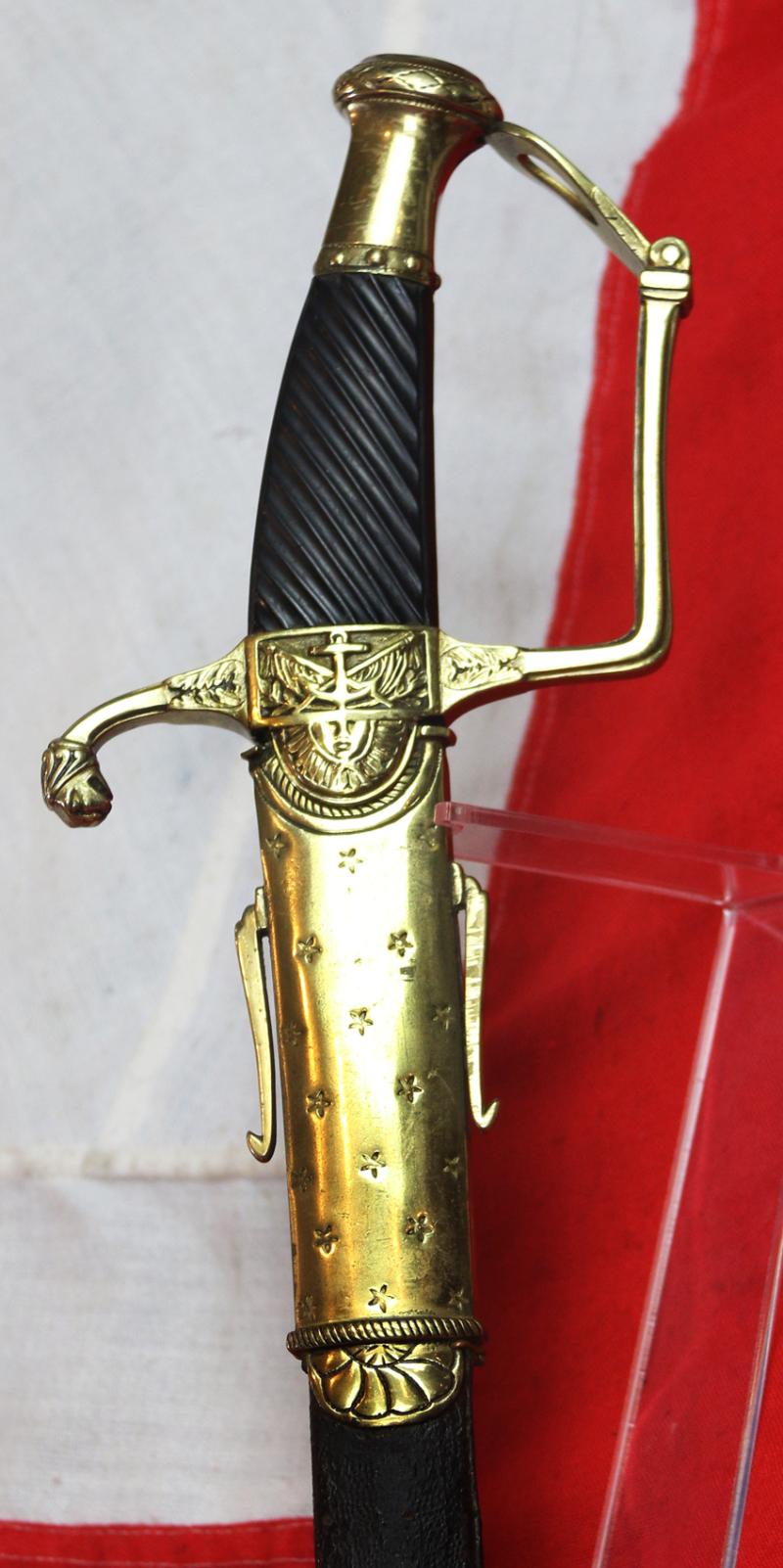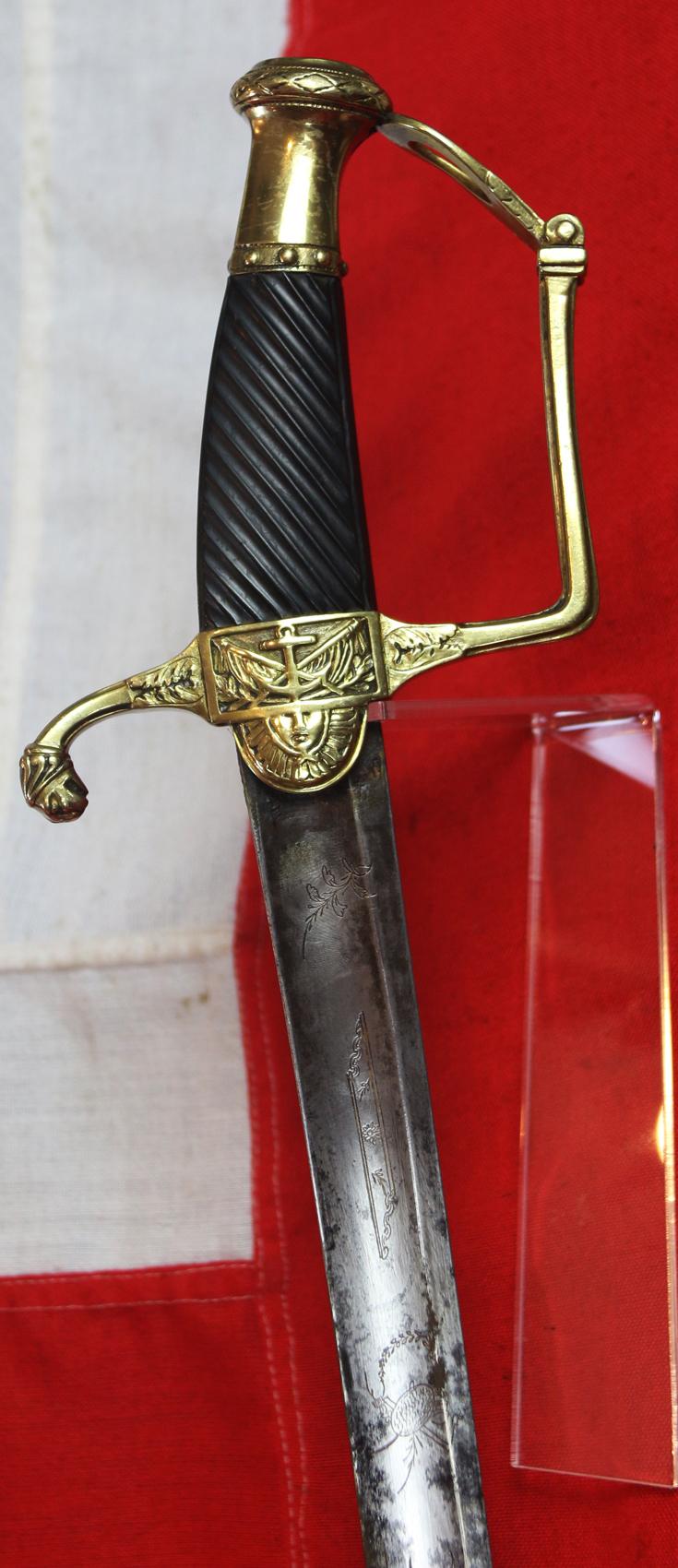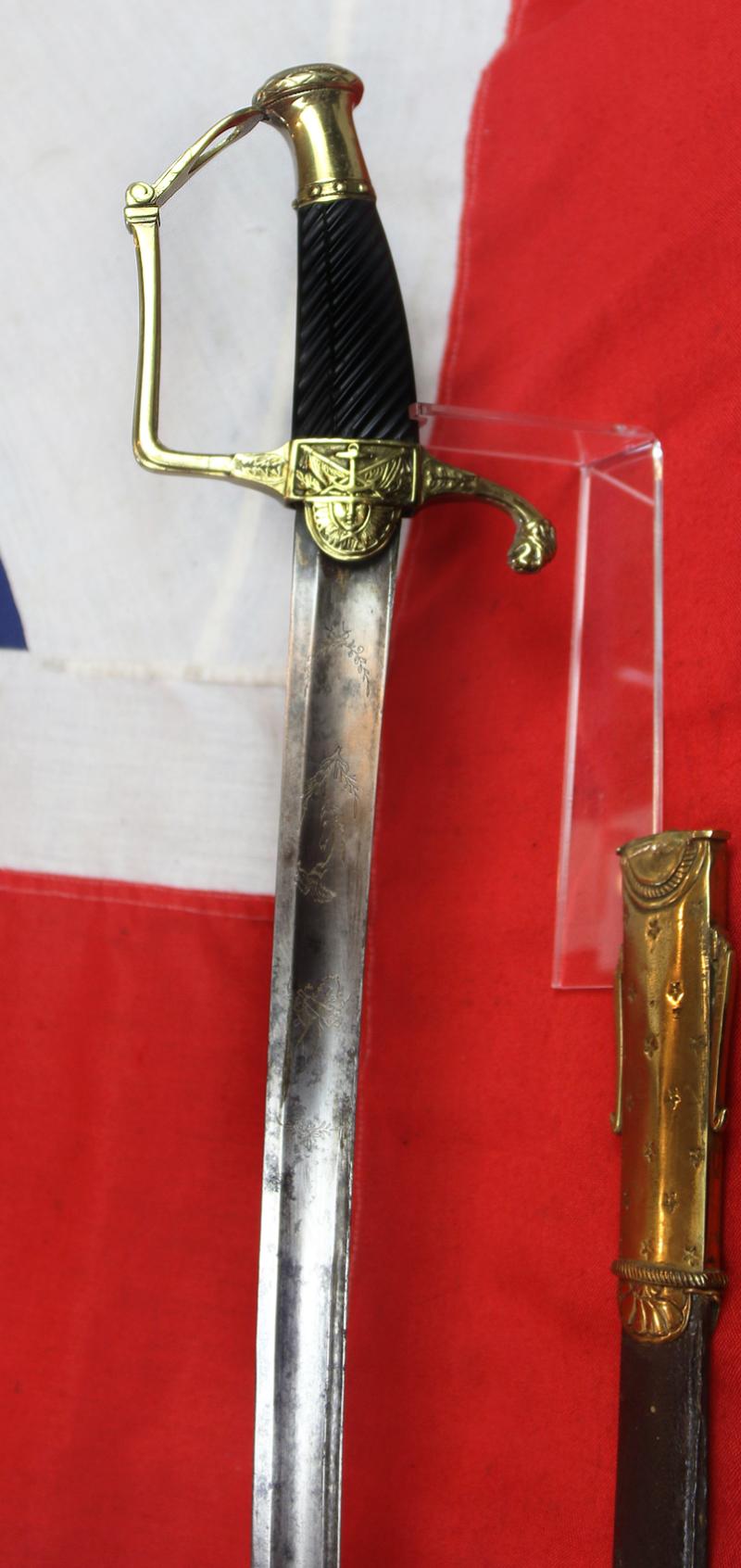An Incredibly Rare French Naval, Sabre D'Officier De Marine Model Prairelle An XII 1804. Officer's Sword, Most Likely Surrendered or Captured At Trafalgar in 1805. Possibly Even From the Redoutable or Bucentaure
Overall in very good condition for age, very tight and sound with no looseness, yet with commensurate wear for its age, considering its use as a hand to hand combat sword in the service of their emperor Napoleon Bonaparte.
It has a very finely engraved blade with feint traces of blue and gilt, and usual age and surface wear overall.
Almost all of the senior French naval officers at Trafalgar could have carried a sword just as this, and this sword may even have been likely surrendered at Trafalgar itself. Its official title is; Sabre d'officier du Marine, modele de Prairal an XII of 1804. Scabbard throat mount beautifully decorated with a Mermaid, with two tails and modest skirt, as was the identifying feature on a naval officer's sabre of the prairial model. The reverse side of the scabbard has a design of a pattern of the constellation of the stars.
It was by formal decree, dated the 7th of Prairial of the year XII May 28, 1804, that the French First Consul Napoleon Bonaparte approved the creation of the model of this stunning sabre. This is such a rare sword they are almost impossible to find, even in museums.
This French naval officer's combat sword is a stunningly beautiful sabre, and so very rare, as so many warships of the French Napoleonic navy, and their officer's and crew, were captured or destroyed so precious few survive. The British equivalent is the rare 1805 pattern Royal Naval officer's sword, which Nelson also took to at Trafalgar, but the French surviving equivalent, this sword, is at least 100 times the rarer sword. The last known example, of a surrendered French ship's captain's sword, we sold here over 5 years ago.
Sabre naval officer model of the 1st Prairial Year XII, guard a brass branch chiselled and gilded, bow body adorned with an anchor resting on two flags, half round langets chiselled with a radiant head, fluted ebony grip with carved grooves; flat-backed blade, one hollow pan and lateral throat, traces of blue and gilded in the third; leather scabbard with seam, two gilded brass fittings, the throat is provided with two long side hooks for the wearing of the sword with a belt or the harness, it is decorated with a mermaid with two tails, finely engraved with reeds; dart shaped shell;
Prairial was the ninth month in the French Republican Calendar. This month was named after the French word prairie, which means meadow. It was the name given to several ships.
Prairial was the third month of the spring quarter.
The Battle of Trafalgar (21 October 1805) was a naval engagement fought by the British Royal Navy against the combined fleets of the French and Spanish Navies, during the War of the Third Coalition (August–December 1805) of the Napoleonic Wars (1796–1815).
Twenty-seven British ships of the line led by Admiral Lord Nelson aboard HMS Victory defeated thirty-three French and Spanish ships of the line under French Admiral Villeneuve. The battle took place in the Atlantic Ocean off the southwest coast of Spain, just west of Cape Trafalgar, near the town of Los Caños de Meca. The Franco-Spanish fleet lost twenty-two ships and the British lost none.
The victory confirmed the naval supremacy Britain had established during the course of the eighteenth century and it was achieved in part through Nelson's departure from the prevailing naval tactical orthodoxy of the day. Conventional practice at the time was for opposing fleets to engage each other in single parallel lines, in order to facilitate signalling and disengagement, and to maximise fields of fire and target areas. Nelson instead arranged his ships into two columns to sail perpendicularly into the enemy fleet's line.
During the battle,Victory locked masts with the French Redoutable, whose crew, including a strong infantry corps (with three captains and four lieutenants), gathered for an attempt to board and seize Victory. A musket bullet fired from the mizzentop of Redoutable struck Nelson in the left shoulder, passed through his spine at the sixth and seventh thoracic vertebrae, and lodged two inches below his right scapula in the muscles of his back. Nelson exclaimed, "They finally succeeded, I am dead." He was carried below decks.
Victory's gunners were called on deck to fight boarders, and she ceased firing. The gunners were forced back below decks by French grenades. As the French were preparing to board Victory, Temeraire, the second ship in the British windward column, approached from the starboard bow of Redoutable and fired on the exposed French crew with a carronade, causing many casualties.
At 13:55, the French Captain Lucas of Redoutable, with 99 fit men out of 643 and severely wounded himself, surrendered. The French Bucentaure was isolated by Victory and Temeraire, and then engaged by HMS Neptune, HMS Leviathan, and Conqueror; similarly, Santísima Trinidad was isolated and overwhelmed, surrendering after three hours.
Nelson was shot by a French musketeer As Nelson lay dying, he ordered the fleet to anchor, as a storm was predicted. However, when the storm blew up, many of the severely damaged ships sank or ran aground on the shoals. A few of them were recaptured, some by the French and Spanish prisoners overcoming the small prize crews, others by ships sallying from Cádiz. Surgeon William Beatty heard Nelson murmur, "Thank God I have done my duty"; when he returned, Nelson's voice had faded, and his pulse was very weak. He looked up as Beatty took his pulse, then closed his eyes. Nelson's chaplain, Alexander Scott, who remained by Nelson as he died, recorded his last words as "God and my country." It has been suggested by Nelson historian Craig Cabell that Nelson was actually reciting his own prayer as he fell into his death coma, as the words 'God' and 'my country' are closely linked therein. Nelson died at half-past four, three hours after being hit, before the battle ended. Villeneuve was captured, along with his ship Bucentaure. He later attended Nelson's funeral while a captive on parole in Britain. Admiral Federico Gravina, the senior Spanish flag officer, escaped with the remnant of the fleet. He died five months later from wounds sustained during the battle. The battle resulted in 10 French ships captured,
one ship destroyed,
3,373 dead,
1,155 wounded,
over 4,000 men captured
Spain:
11 ships captured,
1,022 dead,
1,386 wounded,
3 to 4,000 captured
Total: about 15,000
It would be wonderful to know for certain that this sword was surrendered by such as a senior officer of the Redoutable or Bucentaure , and although it is certainly possible it may have been, in fact we can't say it wasn't, but in reality it is a speculation that may never be satisfied.
The sword is 36.5 inches long overall in its scabbard. The carved ebony grip has one slight split on one side, but still as tight as a drum, the leather scabbard has had a contemporary field service leather repair near the chape.
Code: 25277
6995.00 GBP

